
Written by our friends at Green Mountain Energy
Taking a trip? You booked the tickets, bought a new outfit and told your friends. You packed sunscreen, your IDs, and some extra cash. There’s one more thing to do: make sure your home stays green and energy efficient while you’re gone.
The pros at Green Mountain Energy have shared a few tips to help maintain your eco-friendly home, live a more sustainable lifestyle and keep costs low when you’re away.
Before we dive in: Get a head start on living greener by choosing a 100% clean energy plan from Green Mountain Energy. Plus, you’ll earn 10,000 AdvantEdge Rewards points ($100 value) after 2 months of service and 1,000 points ($10 value) every 6 months for as long as you keep your plan!

You checked your destination, but what about at home? Is it going to be blazing hot or a little cloudy while you’re out? Decide the highest temperature you’re comfortable with so it won’t be stuffy when you get home — about a 5° difference usually does the trick. And don’t forget to close the blinds and pull the shades. All that extra light can heat up your place when you’re not there.

The best way to lower your impact on the planet and save on energy costs is to not use energy at all. You don’t need to unplug your oven, but many electronics use “phantom energy.” They quietly use power even as they sit idle. TVs, air fresheners, alarm clocks — every little bit makes a difference. Even a small appliance like a printer passively uses electricity while it’s plugged in. Try using surge protectors or power strips to make turning everything on and off a breeze.

Smart technology apps and electrical timers can come in handy when you’re away. If you’re worried about your plants getting proper hydration, or if there’s a pet keeping watch at home (or napping all day), create presets to keep them cool during the day and cozy at night. Check out smart thermostats and pre-programmed lights, too. As a safety precaution, you can also set a timer to turn on a few lights when you’re out, so it looks like someone’s at home.

Many of us clean out our refrigerators before we leave town. According to our cool friend science, refrigerators are more efficient when there are more items on the shelf, since cold items help keep other items cold. You can save a little on your bill and help the planet by letting your appliances work for you. If you have liquids or water that’ll keep until you get back home, feel free to leave them on the shelves so your fridge won’t have to work as hard while you’re gone.

This is a more advanced tip, since most of us don’t touch the water heater unless there’s a problem with it. It’s a huge appliance that uses a lot of energy to keep hot water ready for washing dishes and showering. But since you won’t need hot water while you’re gone, why not adjust the water heater for energy efficiency? Many water heater models have a vacation mode, but you can also turn it down manually. Once you return, make sure to follow the Energy.gov recommendations for powering up your water heater when you get home.
Everyone’s lifestyle is different, so no energy tip will be one-size-fits-all. Do what works best for your home, so you can kick back, relax and enjoy your vacation, all while knowing your home is on an energy-efficient staycation.
Safe travels!

Written by our friends at Green Mountain Energy
Say it with us: Earth is awesome! And it also happens to be the only one we have. Every day, we celebrate this beautiful planet we call home, but each April 22, we like to give it a little bit more love.
Earth Day is here again, the perfect opportunity to think about how even the smallest choices can make a lasting difference. The perfect example?
Choosing to power your home with renewable energy!
Did you know that electricity generated from fossil fuels accounts for 25% of man-made greenhouse gas emissions in the U.S.? That means that, by choosing clean energy to power your home, you’re opting out of a full quarter of the national carbon footprint and significantly lowering your own footprint at the same time. Pretty great, if you ask us.
But what if you aren’t using clean energy and you want to start? The answer is simple. All you have to do to choose clean energy is to switch your electricity plan. And when you make that decision today, you can make that impact every day for as long as you stay on your renewable energy plan. It’s really that easy to take a full quarter off your annual footprint.
Make the switch in a snap with a 100% clean energy plan from our friends at Green Mountain Energy. You’ll also earn 10,000 AdvantEdge Rewards points ($100 value) after 2 months of service and 1,000 points ($10 value) every 6 months for as long as you keep your plan.
So, whether you’re new to renewable energy or you’re an old pro, you can celebrate Earth Day at your house all year long with an electricity plan that doesn’t hurt the planet and rewards you!
Written by our friends at Green Mountain Energy
When temperatures drop, it’s time to raise your awareness about ways to conserve energy in your home while keeping warm.
From energy-efficient appliances to tackling some basic home-improvement projects, our cold weather energy tips make it easy to decrease your carbon footprint, all while saving on energy costs.
- Make smart heating choices
Heat is essential during the colder months, but heating your home can make up half of your energy costs. Stay savvy when it comes to running your furnace to warm your home with a few simple adjustments.
– Perform any seasonal maintenance on your heating system.
– Give your home time to warm once the heater is turned on. Bursts of hot air won’t make it warm any faster.
– Be sure dirty air filters aren’t making your system work harder; clean regularly and replace them as needed.
– Reverse your ceiling fan. Position the blade direction clockwise to push warm air down from the ceiling to the floor.
– Don’t block vents or registers, so heat has a clear path into the room.
– Use the sun to your advantage by opening curtains and blinds during the day (especially on the south side of your house). Close them at night to reduce drafts.
- Weatherize your home
With cooler temperatures and fewer insects around, it’s a perfect time for home maintenance. Making a few changes to your home can help you save on energy costs and help the planet.
– Upgrade your windows from single to double pane (watch for ENERGY STAR options to increase your savings). If that’s out of your budget, utilize coverings like blinds, drapes, solar film, or shades.
– Check insulation thickness and add more if necessary.
– Weatherize your home using caulk or weather stripping. Seal air leaks around letter drops, vents, door frames, and windows. Don’t forget the attic, where there are small openings that are often overlooked.
– Upgrade your appliances to the most energy-efficient options. Watch for ENERGY STAR labels and ensure the size matches your needs.
- Adjust your appliance use
Your appliances got a serious workout during the summer heat, so give them a break. Making a few minor adjustments to your appliances can help you conserve energy and save money.
– Turn your refrigerator to an energy-saving setting.
– Reduce the temperature to 120° on your water heater and wrap an insulating blanket around it.
– Be sure to wash laundry in warm or cold water.
- Use smart gadgets
Thanks to advances in smart technology, it’s easy to automate your home to fit your unique lifestyle. Best of all, taking advantage of smart gadgets can help you save on energy costs in your home.
– Opt for LED lights. They use 90% less electricity and last longer than traditional bulbs.
– Use smart power strips to turn off your electronics. You can even create a master setting to automate your usage.
– Programmable thermostats allow you to customize heating schedules that fit your routine.
– Use motion sensors and timers for outside lighting to minimize unnecessary use.
– Use solar lighting for your lawn and garden.
It’s easy to stay eco-friendly when you tap into our cold weather energy tips. Our Green Living Tips have even more ways to live greener while saving a little green when temperatures drop.
We’ve partnered with Market 32 to offer a clean energy plan that rewards you with 10,000 AdvantEdge Rewards points ($100 value) after 2 months of service, and 1,000 points ($10 value) every 6 months for as long as you stay on your plan! Learn more at greenmountainenergy.com/market32.
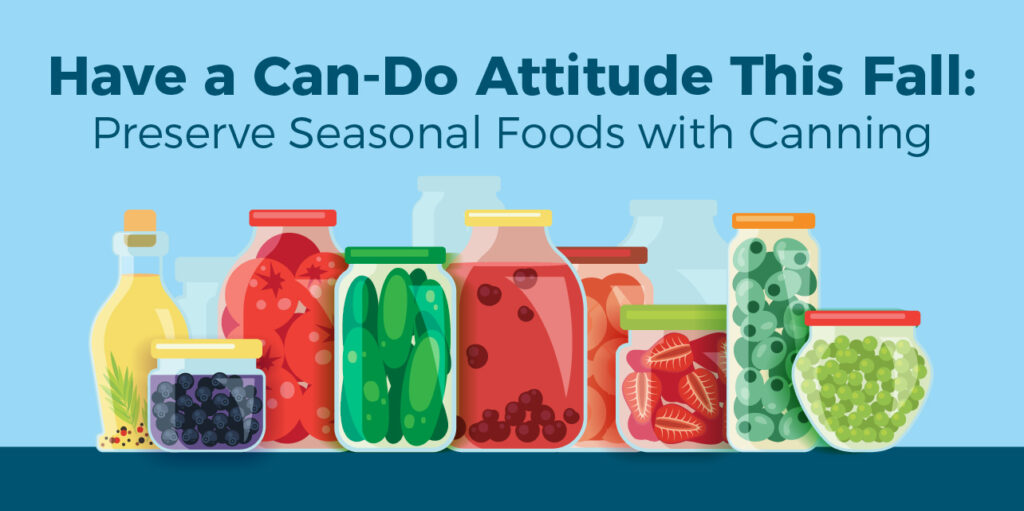
Written by our friends at Green Mountain Energy
Do you love summer farmers’ markets but wish you could use those flavors for a Thanksgiving cobbler? Wish you could reduce the waste from store-bought canned goods? Did your backyard garden give you way more produce than your household can possibly eat before it turns? It’s time to get canning!
Canning isn’t just for your grandparents anymore, but they were certainly onto something—it’s the greenest way to take your pantry to the next level. Home-canned food offers plenty of benefits, like:
– Seasonal produce year-round. Fresh fruits and vegetables found at the height of their season at your local farmers’ market in the summer can make a tasty appearance on your table any time of year.
-Knowing what’s in your food. Since the only thing in your canned food is what you put into it, it’s a good way to avoid artificial additives.
-Room for creativity. You can try out new recipes for jams, soups, salsas and more.
-Eco-friendliness. Canning cuts down on food waste, reduces emissions from transporting food, and minimizes single-use plastics.
-Saving time. Too rushed to make dinner from scratch? Reach for that yummy homemade soup or pasta sauce you canned in advance.
Before you get started, make sure you have the basics on hand:
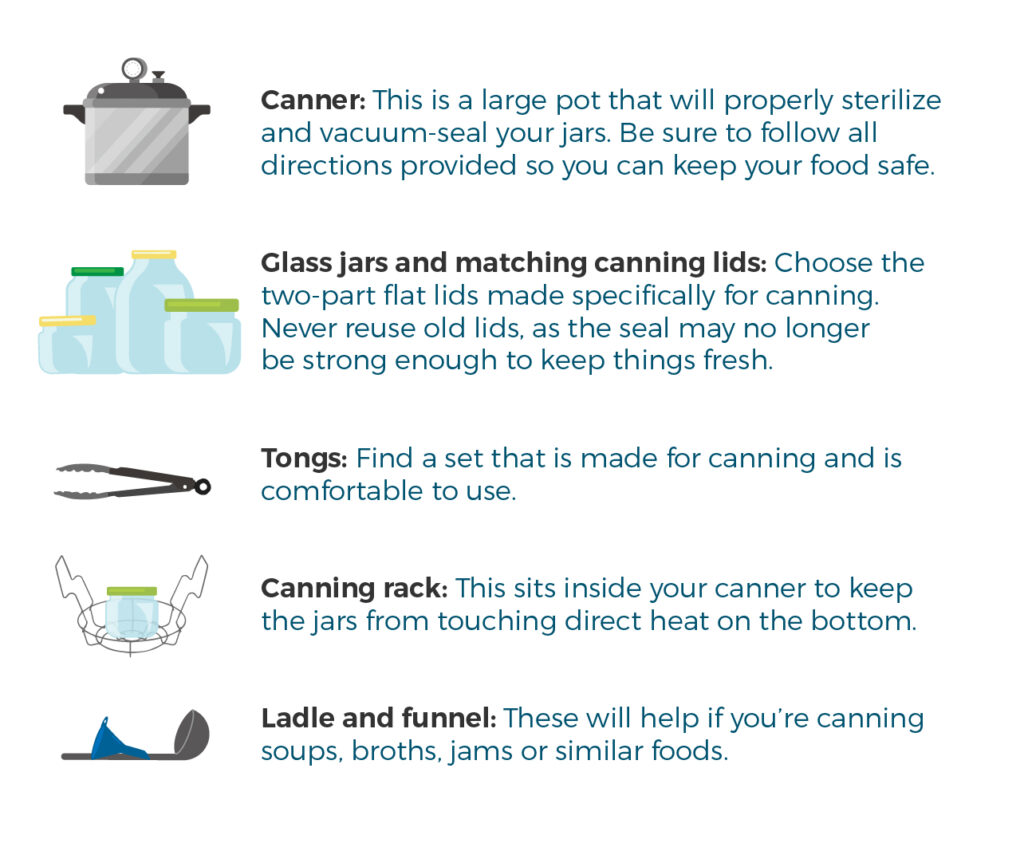
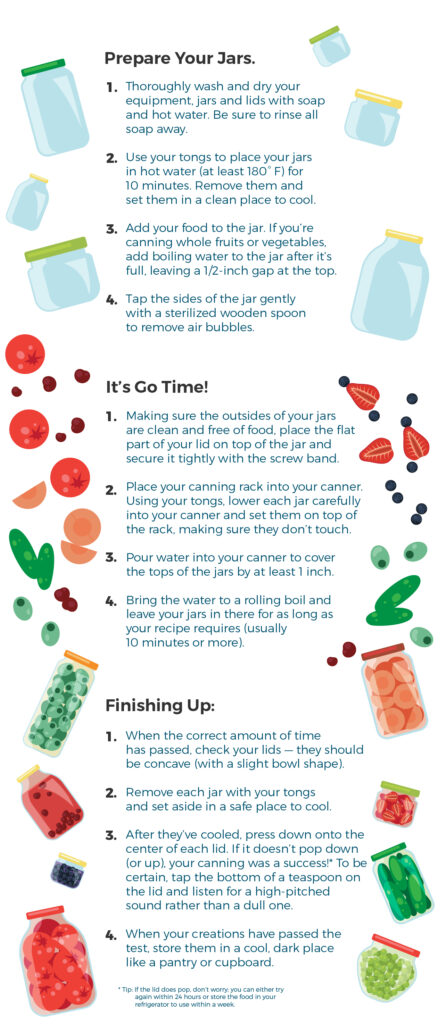
This is just an overview of the canning process. Check out more detailed information from the National Center for Home Food Preservation. We hope you have a great time getting creative and cutting down on food waste with this time-honored activity!
More ways to live sustainably:
Canning is an excellent (and tasty) way to cut back on food waste and plastic use, but your green efforts don’t have to stop there! Since you’re on a roll, see our other simple tips for cultivating an Earth-friendly lifestyle on our blog here.
Our favorite way to live greener is also one of the easiest: choosing to use clean electricity in your home. We’ve partnered with Market 32 to make going green even more rewarding, featuring 100% renewable energy plans that let you save at the checkout line. Learn more here.

Written by our friends at Green Mountain Energy
When it comes to living greener, mealtime is the right time to make a big difference. Though you may not realize it, our eating habits can be harmful to the environment. Here are a few mindful practices that can make it easier to eat and live more sustainably, courtesy of Green Mountain Energy.
Mindful eating
Mindful eating means knowing where your food comes from. Livestock production requires much more food, water and energy use than it takes to produce plants. To offset this, prioritize produce and cut back on animal products like meat, dairy and eggs.
Sustainable plant agriculture (like low-carbon production and avoiding pesticides) and animal agriculture (like buying local and considering the health and well-being of the animals) leads to a healthier life and greener lifestyle.
Cooking at home
Homemade meals give you more control over your choices, starting with local, eco-friendly ingredients, and ending with how much food you waste.
Food waste accounts for about 21% of landfill volume. As it spoils in the heat, it releases gases that harm the planet. There are easy ways to whittle down food waste, like using every part of the vegetables you eat, like broccoli stems, and composting leftover scraps for your garden. Read more about how to eliminate food waste in this blog.
Safe, sustainable serving
At Green Mountain Energy, we’re working to show people how every single decision we make can help or harm the environment, down to the plates we use at dinnertime. You can dish up a side of sustainability at every meal by considering what you eat it on and how you serve it.
Your dinnerware comes in direct contact with your food, so choose chemical-free and non-toxic options.
Go a step further with recyclable, American-made and eco-friendly dinnerware. Wood, bamboo or recycled-glass materials are great options. Also look for renewable materials when it comes to cutting boards, placemats and more.
Smart storage
Use reusable bowl covers or organic cotton wraps like these instead of plastic wrap. For storage containers, skip the plastic variety and opt for recycled glass or stainless steel.
Storing food properly is important, and that includes knowing how long you can store it. Freshness maximizes food safety and quality. Fish should remain in the fridge no longer than two days, while meat should be eaten between two and four days after being stored. Remember, produce lasts much longer and is better for your body and the planet. Check out the expiration dates for all your favorite foods here.
Keep your green momentum going
When it comes to food, use sustainable practices for the health of yourself and the planet. But don’t stop there! We’ve gathered up more simple tips for cultivating an Earth-friendly lifestyle on our blog here.
Our favorite way to live greener is also one of the easiest: choosing to use clean electricity in your home. We’ve partnered with Market 32 to make going green even more rewarding, featuring 100% renewable energy plans that let you save at the checkout line. Learn more here.
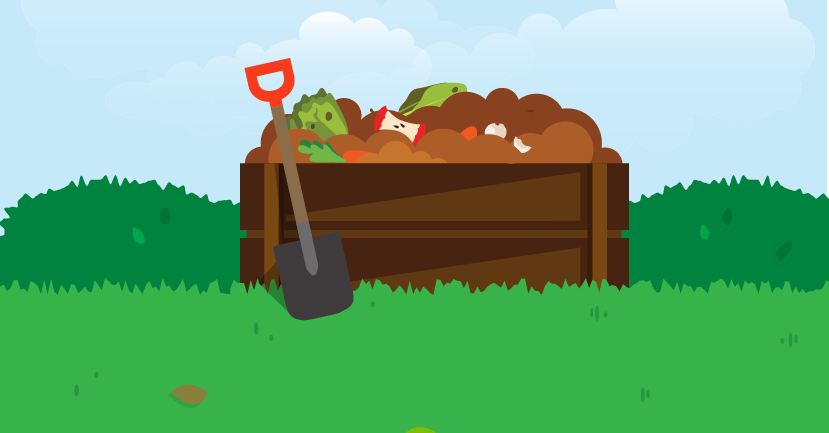
Written by our friends at Green Mountain Energy
Composting is a great, easy way to green up your daily routine. Green Mountain Energy has what you need to know to get started on your composting journey.
When you throw away food scraps and yard waste, there’s a good chance it will end up in a landfill, creating more methane gas. But did you know there’s a way to turn 28% of that waste into something useful for our environment? That’s the kind of impact the average household could have, just by incorporating composting into their daily lives.
If you’ve never considered composting before, don’t sweat. Green Mountain Energy is here to show you how with some simple tips for beginners who are ready to do some good for the planet.
What can you compost?
Compost is used to nourish plants and fortify the soil, so anything you put into your compost bin should be natural — think fruit and vegetable peels, coffee grounds, eggshells, paper, yard trimmings and even tea bags. You can also include things like fireplace ashes, dryer lint and even the contents of your vacuum cleaner. Have four-legged family members? Good news: You can compost all that hair they generously leave behind.
Don’t include things like dairy, meat, bones, oils and fats, charcoal ash, diseased plant clippings or anything that has been treated with pesticides.
A quick tip here: If you buy conventional bananas and oranges, the peels usually contain pesticides. You may want to skip those, or switch to organic. Also avoid pet waste like cat litter and puppy “presents.” Those materials could contaminate the compost and harm plants or soil.
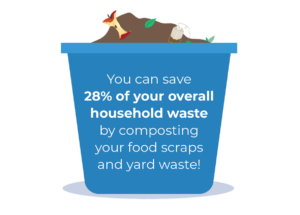
What do you need?
At Green Mountain Energy, we’re working to show the world how easy it can be to make a green impact. That’s why we think composting is a great addition to any household: It works just about anywhere, and you don’t need many supplies to get started.
You can compost indoors or outdoors, so even if you don’t have a backyard, you can still start a small compost pile in your kitchen or on an apartment patio. For indoor or patio composting, you’ll need a special indoor composting bin, available online or from home improvement stores. And here’s the best part — you don’t need earthworms indoors!
Backyard composting is a little more flexible. You can use a composting bin, or you can start a compost pile in a shady area. If you go the DIY route, the compost needs to sit on bare dirt to attract worms and beneficial bacteria, so be mindful as you choose a spot.
Once you’ve decided on a bin or an outdoor spot, you’ll need a bucket for collecting scraps from the kitchen. It can be anything from an old plastic ice cream container to a fancy stainless-steel compost bucket with carbon filters. Try to choose one with a lid to keep odors contained. Consider storing it under the kitchen sink, so it’s out of the way but still easy for everyone in the family to access.
How to start composting
Once you’re set with a location and collection pail, it’s time to start layering and aerating. Composting is all about layering materials, getting a good mix of different things to create a nutrient-rich conditioner for your soil and keeping your material oxygenated.
The scraps and waste you include will either be carbon-based “brown materials,” such as leaves, brown paper bags, coffee grounds and eggshells, or nitrogen-based “green materials,” including fruit and vegetable scraps and lawn clippings.
Try to include a mix of one-third green and two-thirds brown materials for the best compost nutrient profile. If odor is ever a problem, add more carbon-based, brown materials. They can absorb odors caused by nitrogen-rich green waste.
To keep compost from getting moldy, and to help speed up the breakdown of materials, you’ll need to mix the compost to keep air moving throughout the pile.
Many indoor and outdoor bins have a tumbler feature to make this process a breeze. You just crank a handle to spin the container or move paddles through the compost, and aeration is done. You can also use a shovel, rake or hoe to move an outdoor compost pile around every week. Just be sure to get air circulation all the way through the pile to the bottom.
Depending on the size of your pile and how often you aerate, it may take six months to a year before outdoor compost is ready to use in the garden. Smaller indoor composters and tumblers are generally faster, producing usable compost in as little as a few weeks. Whether fast or slow, that’s a lot of kitchen and yard waste that won’t end up in a landfill.
More tips for green living
Composting is just the beginning when it comes to living more sustainably. We’ve gathered up more simple tips for cultivating an Earth-friendly lifestyle on our blog here.
Of course, the Green Mountain Energy mission was built around one of the easiest ways to do good for the environment: Choosing electricity that comes from clean, renewable sources like the wind or the sun to power your home — no equipment or installation required.
We’ve teamed up with Price Chopper & Market 32 to make living greener even more rewarding with special clean energy offers, including a 100% renewable energy plan and an invitation to join the Green Mountain Community Solar Program. Learn more here.


